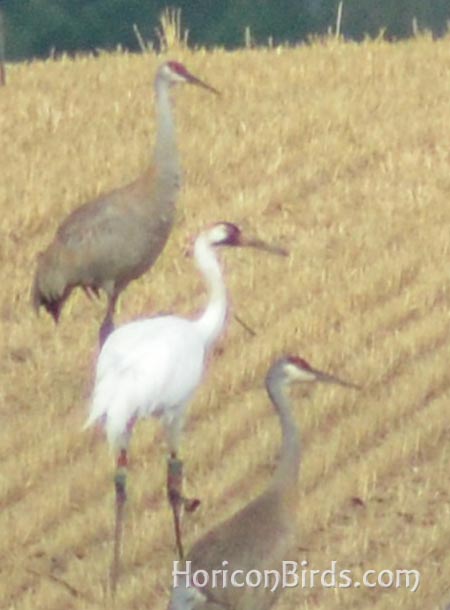|
Whooping crane sighted among sandhills near Horicon
by Pam Rotella
21 July 2012
HoriconBirds.com
I was lucky enough to spot a whooping crane among a large flock of more than 150 sandhill cranes on Thursday, 19 July 2012. The birds were feeding in a previously harvested farm field along Rockvale Road, near Horicon Marsh and Dike Road. I assume they were looking for waste grain or insects who had emerged after the thunderstorms of the previous day.
The cranes were far back from the road, and the first picture that I have of the entire flock is as follows (notice the white speck in the upper left -- that's the whooping crane):
I was able to count the sandhill cranes by taking the full-sized picture (which is 4 MB big and too large to display here) and sectioning it into natural breaking points. I then enlarged one section at a time to count the birds in each. (Photographers have this luxury -- people in the field may have to eyeball the birds for a quicker, less accurate count.) I may have missed a crane or two if they were behind another bird and an obvious extra set of legs or an extra neck and head weren't visible, but this is a fairly accurate count.
From the following sectioned photo, I counted 159 sandhill cranes, plus the one whooping crane:
 To the right is an enlargement of the whooping crane. This is a poor quality picture because even with my long 300 mm lens extended all the way out and software enlargement after the fact, the flock was too far away for quality pictures of individual birds.
To the right is an enlargement of the whooping crane. This is a poor quality picture because even with my long 300 mm lens extended all the way out and software enlargement after the fact, the flock was too far away for quality pictures of individual birds.
I was able to see the whooping crane's "jewelry," installed by humans -- color banding on one leg, a transmitter on the other. I took the photo chip to the visitor's center, and one of the women on duty wanted to report the color banding. She patiently waited while I enlarged photo after photo until we found an image with good enough resolution to see the color pattern clearly.
Whooping cranes have been sighted and tracked through radio transmissions in and around Horicon Marsh. Anyone who sees a whooping crane is encouraged to report its color banding, if visible, along with its location.
Fortunately for this crane, there were no signs of human imprinting. The bird was shy and stayed away from the road where cars were passing. However, it's possible that this crane has imprinted on sandhills, and that's why it's staying with that flock. I'm sure we'll hear more about its travels in years to come.
Follow-up note 24 July 2012: Eva Szyszkoski of the International Crane Foundation has provided a link on this crane's history (including a really cute picture of him as a chick), along with the following information:
"This is one-year-old male #16-11. He was hatched at the International Crane Foundation and released with seven other juveniles at the Horicon NWR in October 2011 in the presence of sandhill cranes. He wintered at an unknown location and reappeared on spring migration in Jackson County, Indiana, before completing migration back to Wisconsin by early April."
Sighting of 21 July 2012: I spotted a whooping crane in the marsh on Saturday, 21 July, although its leg bands weren't visible due to tall grasses. I assume this was the same bird, again in the company of sandhill cranes. All of my photos of him are grainy because he was such a distance from the road, in fact I wasn't sure that he was a crane until I enlarged the photos. The best picture that I have of him follows...
All original content including photographs © 2012 by Pam Rotella.
|